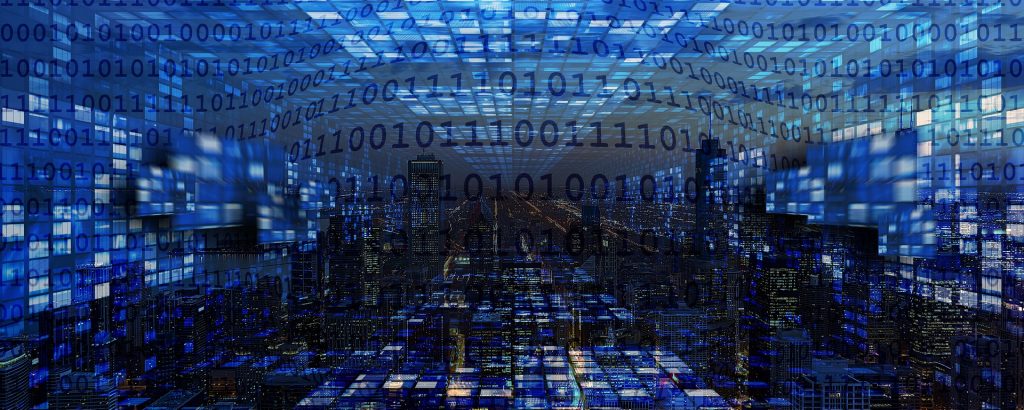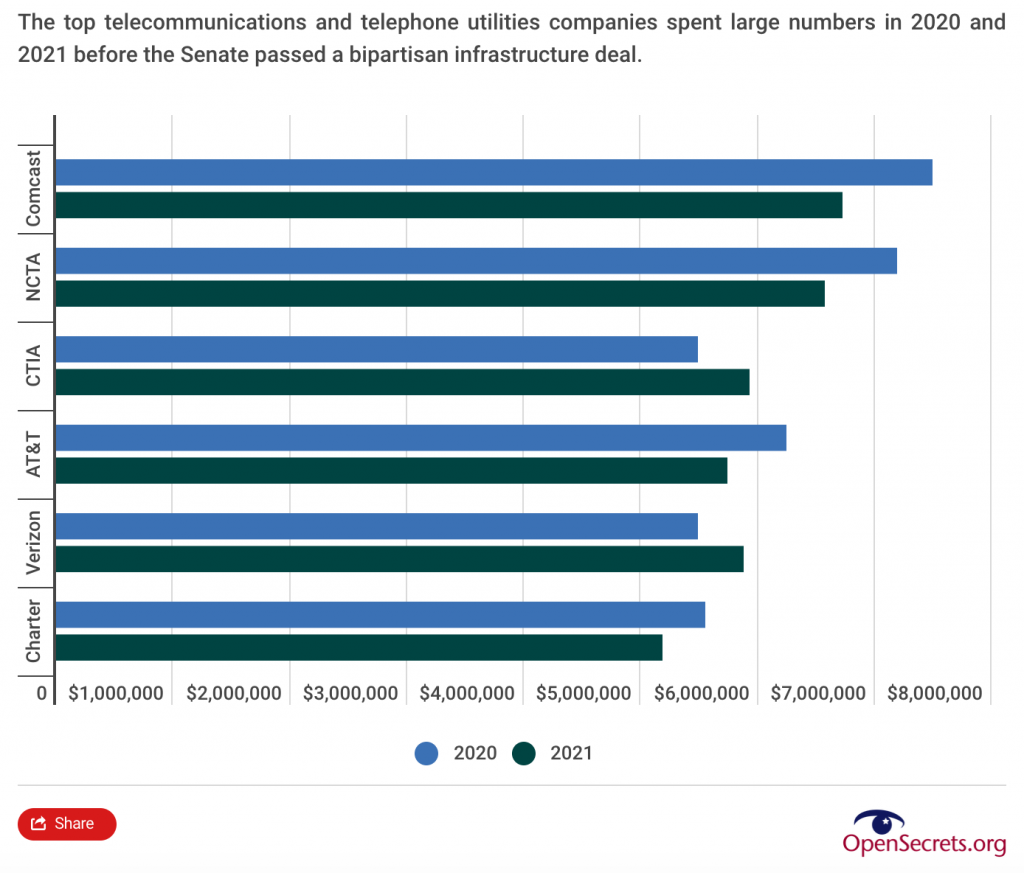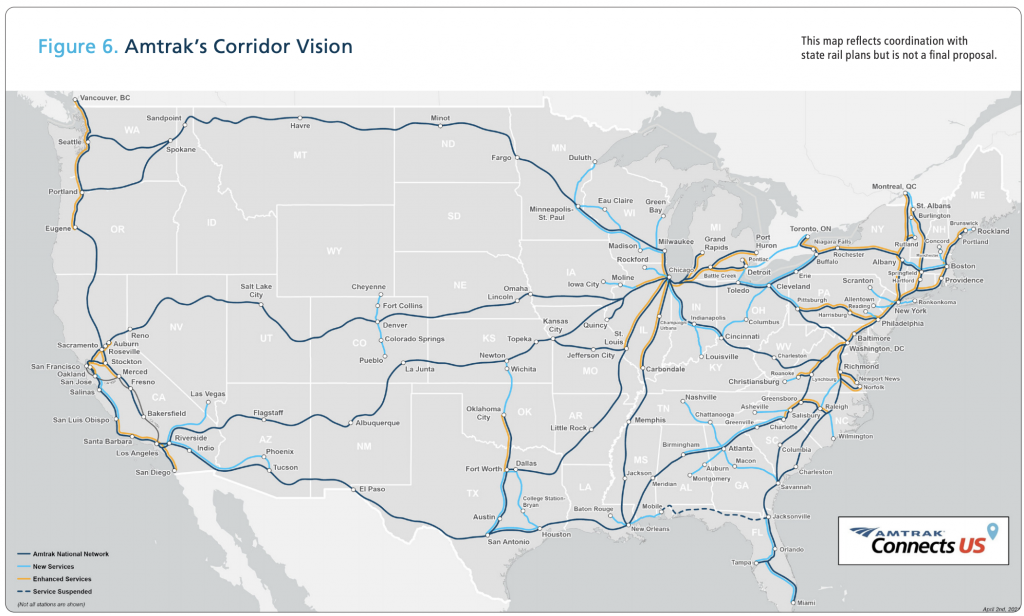On November 5, 2021, Congress passed the Infrastructure Investment & Jobs Act (H.R.3684) which was signed by the President on November 15. Yet another $1.2 trillion in nefarious “investments” to keep the money presses rolling. Most media sources summarize the 2740-page bill by lumping everything into spending categories, while leaving out some of the most critical data that shows what they really intend to fund. This report breaks down several key data and funding points, while drawing attention to some of the more questionable allocations.
Keep In Mind We Are Being Heavily Censored, Please Follow Us On Our Social Media Pages: Telegram USA.Life, Gab, Parler, Minds, Spreely, MeWe, Twitter, Facebook
This Infrastructure Bill also reveals how the entire transportation system is going to have control over what everyone drives including vehicle-to-grid 5G technology with kill switches installed, when they drive, access to transportation, an integrated payment system including a per-mile driving fee, the evolution of autonomous vehicles, buses, truck lines, and Amtrak’s expansion to reduce vehicles on the road. This bill boasts 27 pilot programs they want to document and roll into legislation for additional future control, and their “Build Back Better Bill” would provide the added funding for some of them, if that bill manages to get passed through the Senate.
The Nutshell Version Of Prime Funding Categories
Roads and bridges – $110 billion
Power grid – $73 billion
Railways – $66 billion
Broadband internet – $65 billion
Drinking water – $55 billion
Resilience & climate change – $50 billion
Airports & waterways – $42 billion
Public transit – $39 billion
Environmental – $21 billion
Transportation safety – $11 billion
Electric vehicles – $7.5 billion
Electric buses, ferries – $7.5 billion
This accounts for $547 billion in new spending over the course of five years, or additional funding, added to their already allocated funding for highways and infrastructure projects, totaling $1.2 trillion.
Strategic National Stockpile
Stuffed inside this bill on page 2359, they are amending Section 319F-2(a) of the Public Health Service Act (42 U.S.C. 247d-6b(a)) to add the following at the end:
“TRANSFERS OF ITEMS – The Secretary, in coordination with the Secretary of Homeland Security, may sell drugs, vaccines and other biological products, medical devices, or other supplies maintained in the stockpile under paragraph (1) to a Federal agency or private, nonprofit, State, local, tribal, or territorial entity for immediate use and distribution, provided that any such items being sold are (A) within 1 year of their expiration date; or (B) determined by the Secretary to no longer be needed in the stockpile due to advances in medical or technical capabilities.”
Word Use Throughout The Bill, For Perspective
Grant is used 2,115 times
Transportation is used 1,187 times
Energy is used 978 times as opposed to “Roads” being used 900 times or “Highway” 512 times
Pilot Program is used 262 times
Cybersecurity is used 234 times
Partner is used 182 times
Resilience is used 145 times
Nonprofit is used 88 times
Stakeholder(s) is used 69 times
Smart is used 63 times
Greenhouse is used 37 times
New Councils And Task Forces Being Created
• Energy Jobs Council
• Motorcyclist Advisory Council
• Nontraditional and Emerging Transportation Technology Council
• Rural Opportunities to Use Transportation for Economic Success Council
• Task Force on Producer Responsibilities (batteries)
• Truck Leasing Task Force
What States Are Receiving The Most Funding?
Based on the funding allocations documented in the White House Fact Sheets, the states that will benefit the most are California, New York, and Texas. Each will be receiving over $25 billion. Arizona, Oregon and Washington will each be receiving $40 million to assist with protection against wildfires. Michigan is receiving $1.3 billion to improve its water infrastructure. According to U.S. News Analysis, West Virginia, Rhode Island, and Mississippi have the worst infrastructure.
Here are the individual state fact sheets to see some of the programs or developments coming to each state. These won’t include many of the grant programs and pilot programs that are open to many states, but they break down the established funding for specific projects. They utilize a funding formula based on land mass, the number of bridges, miles of highways, transit service data, weather events, census data, and other factors, so some states receive far less than others, which doesn’t always balance out with the needed infrastructure.
Pilot Programs To Monitor

Note that these are only the pilot programs they are rolling out which will ultimately include public-private partnerships with grants and funding, but there are also other new programs being implemented as well as “grant programs.” Pilot programs are entirely new programs to show the validity and “new need,” so they can move to pass legislation making them permanent in every state. Some of the pilot programs do not indicate the specific funds that will be allocated, as some are based on wages, or being pulled from other areas already included in the bill. Those that do indicate the funds, the amount is documented below.
27 Pilot Programs:
• Advanced Transportation Research Pilot Program – $250 million
• Alternative Water Source Projects Pilot Programs under Clean Water – $125 million
• Apprenticeship Pilot Program under Motor Carrier Safety
• Carbon Capture Large-Scale Pilot Projects under Authorization of Appropriations for Energy Act – $937 million
• Critical Minerals: Processing, Recycling, or Development Pilot Programs – $400 million
• Data Integration Pilot Program – $50 million
• Electric or Low-emitting Ferry Pilot Program under Clean School Buses and Ferries – $250 million
• Emerging Technology Research Pilot Program – $50 million
• Energy Efficiency Materials Pilot Program under Schools and Nonprofits – $250 million
• Energy Storage Demonstration Projects Pilot Program – $355 million
• Expedited Project Delivery for Capital Investment Grants Pilot Program
• Federal Share Flexibility Pilot Program
• Innovative Coordinated Access and Mobility Pilot Program under section 3006(b) of the Federal Public Transportation Act of 2015 – $24 million
• Lead Inventorying Utilization Grant Pilot Program – $10 million
• National Motor Vehicle Per-Mile User Fee Pilot Program – $50 million
• Open Project and Research Proposal Pilot Program – $75 million
• Prioritization Process Pilot Program under Planning and Performance Management – $50 million
• Reconnecting Communities Pilot Program under Miscellaneous – $500 million
• Rural and Low-income Water Assistance Pilot Program under Drinking Water
• Rural and Tribal Assistance Pilot Program – $10 million
• State Incentives Pilot Program
• Toll Credit Exchange Pilot Program
• Transportation Access Pilot Program
• Use of Agricultural Commodities in Construction and Consumer Products under Bioproduct Pilot Program – $4 million
• Wastewater Efficiency Grant Pilot Program under Clean Water – $100 million
• Water Data Sharing Pilot Program under Clean Water – $75 million
• Wildlife Crossings Pilot Program – $350 million
Example #1: Reconnecting Communities Pilot Program
The Reconnecting Communities Pilot Program that has $500 million in funding, is specifically for surface-transportation related business to serve minority and women business owners.
Example #2: National Motor Vehicle Per-Mile User Fee Pilot Program
This is a program to charge a per-mile user fee to “road users operating motor vehicles on the surface transportation system, and is based on the number of vehicle miles traveled by an individual road user.” They would like to demonstrate how a national motor vehicle per-mile user fee can restore and maintain the Highway Trust Fund and improve the surface transportation system.
They have designated $50 million to carry out this pilot program that will essentially result in a national per-mile fee anytime a person pulls out of their driveway.
Example #3: Emerging Technology Research Pilot Program
This program consists of research and development of advanced and additive manufacturing technologies to increase the structural integrity of surface transportation, including laboratory and test track supported accelerated pavement testing research for the impacts of connected, autonomous, and platooned vehicles on the pavement, in anticipation of increased usage of automated driving systems and driver assistance systems.
Deploying Their Monitoring And Control System

Smart Grid
“Development of a programmable and efficient energy transmission and distribution system to support the adoption or expansion of energy capture, electric vehicle deployment, or freight or commercial fleet fuel efficiency.” This will also include smart grid traffic signals that can detect vehicles, bicycles, and pedestrians, along with connected vehicle technologies.
Smart Grid projects also include devices, hardware and software, utility communications, and buildings that communicate with the smart grid.
They are also providing a “Smart Grid Investment Matching Grant Program” at a cool $3 billion. A “Smart Grant” can also be used for: acquisition of real property (including land and improvements to land relating to an eligible project).
Electric Vehicle Charging Stations And Vehicle-To-Grid Technologies
They plan to expand deployment of electric vehicle charging infrastructure, hydrogen fueling infrastructure, propane fueling infrastructure, or natural gas fueling infrastructure. This infrastructure must be “responsive to technology advancements, such as autonomous vehicles, vehicle-to-grid technologies, and future charging methods. This infrastructure must also be included along the national highway freight network and in proximity to intermodal transfer stations, along alternative fuel corridors that are designated in the bill, off-highway travel centers, fuel retail centers, and small businesses.
Advanced Impaired Driving Technology
Tucked into pages 1057-1062, states that within the next three years the secretary shall issue a final rule prescribing a Federal motor vehicle safety standard requiring all passenger vehicles manufactured after the effective date (within 2-3 years of new rule), be equipped with advanced drunk and impaired driving prevention technology.
How will this technology work? It will passively monitor the performance of a motor vehicle to “accurately” identify if the driver is impaired and detect the blood alcohol concentration of the driver. If it deems the driver guilty, they are cut off. It will prevent or limit the vehicle’s operation. In other words, they will be installing kill switches in all new vehicles, that will “passively” (always) monitor a person’s driving, tracking their every move, with the ability to remotely prevent them from leaving their driveway, stranding them at some other location they are at, or quite possibly kill the engine while in route. What could go wrong?
Advanced Transportation Technologies And Innovative Mobility Deployment Grant Program
Advanced transportation technologies include intermodal connectivity and infrastructure return on investment. They also intend to build out trails and biking paths, new bus rapid transit corridors or dedicated bus lanes, and of course the large expansion of Amtrak’s passenger rail service.
They plan to “retrofit dedicated short-range communications (DSRC) technology deployed as part of an existing pilot program to cellular vehicle-to-everything (C–V2X) technology, subject to the condition that the retrofitted technology operates only within the existing spectrum allocations for connected vehicle systems.”
They are updating subparagraph (F)(ii)(IV), by striking ‘‘efficiency and multimodal system performance’’ and inserting ‘‘mobility, efficiency, multimodal system performance, and payment system performance.”
Other key clauses being added to and/or altered:
• “…facilitate account-based payments for transportation access and services and integrate payment systems across modes.”
• “Incentivize travelers to share trips during periods in which travel demand exceeds system capacity; or to shift trips to periods in which travel demand does not exceed system capacity.”
• “…integrated corridor management system; advanced parking reservation or variable pricing systems.”
• Insert “toll collection” after “pricing.”
• “…technology that enhances high occupancy vehicle toll lanes, cordon pricing, or congestion pricing; integration of transportation service payment systems.”
• Strike “and access” and insert “access, and on-demand transportation service.”
• After “ridesharing” insert “and other shared-use mobility applications.”
To summarize, they want to build out a system of electric and autonomous vehicles, utilizing electric charging stations, while creating “system capacity” limitations on people so they can only travel when allowed, with a full integrated payment system in place to include more tolls and “access” via payment to transportation services. All transportation will be equipped with 5G capabilities, kill switches, and “vehicle-to-grid” infrastructure to monitor and control every move. The “vehicle-per-mile” pilot program indicates that they intend to charge a per-mile fee to people who use their “transportation surface system,” which ties in well to their entire “integrated” monitoring smart grid. They refer to people as a “road user” no longer free to travel unless they pay the price. They like to refer to all of this as providing safe and sustainable “transportation options.”
The autonomous vehicles of the not too distant future will also include trains, buses, and trucks. In fact, TuSimple has already created a freight network (AFN) with self-driving trucks, has had contracts with USPS, and UPS Ventures took a minority stake in TuSimple. They plan to begin selling a driverless version of a Navistar International Class 8 truck in 2024. Their rival Plus, is anticipating to able to remove the driver from its autonomous trucks by the end of 2024. Investors appear to be pouring money into both companies and Morgan Stanley views TuSimple as an early leader in the commercial truck autonomy. Both companies have come under scrutiny due to their ties with China, but have established themselves in the U.S., and seem to be forging ahead nonetheless.
Broadband Internet
A whopping $65 billion is streaming into broadband internet, and every state will get a slice of the pie. Under the guise of “digital equity,” “cybersecurity,” and “climate-focused environmental monitoring,” they are making certain that everyone is wired up and wired in.
Any broadband networks built must be able to easily “scale speeds over time for evolving connectivity needs, including deployment of 5G, successor wireless technologies, and other advanced services.”
Within 180 days of this ACT, the Comptroller General of the United States must submit a report to congressional committees that estimates the number of skilled telecommunication workers that will be required to build and maintain a broadband infrastructure in rural areas, current need, project need, “if Congress enacts legislation that accelerates broadband infrastructure,” and the infrastructure needed to support 5G wireless technology.
Top six telecom lobbying spenders

Geomatic Data
“The Secretary shall develop guidance for the acceptance and use of information obtained from a non-Federal entity through geomatic techniques, including remote sensing and land surveying, cartography, geographic information systems, global navigation satellite systems, photogrammetry, or other remote means.”
The Secretary will provide the public with notice of the proposed guidance where comments by the public can be made, prior to issuing any final guidance.
Climate Change Agendas
Sec. 11401. Grants for charging and fueling infrastructure.
Sec. 11402. Reduction of truck emissions at port facilities.
Sec. 11403. Carbon reduction program.
Sec. 11404. Congestion relief program.
Sec. 11405. Promoting Resilient Operations for Transformative, Efficient, and Cost-saving Transportation (PROTECT) program.
Sec. 11406. Healthy Streets program.
“Healthy streets” will be funded at $100 million per year for years 2022-2026, to allegedly install new surface pavement with reflective surfaces to decrease the surface temperature of the pavement.
The “reduction of truck emissions at port facilities program” will receive $250 million over the course of five years. Under this program, the Secretary will establish a program to reduce idling at port facilities, potential electrification of port operations, and award grants to fund projects that will reduce emissions at ports.
A “carbon reduction” strategy consists of a project that is designed to “support congestion pricing, shifting transportation demand to non-peak hours or other transportation modes, increasing vehicle occupancy rates, or otherwise reducing demand for roads, including electronic toll collection, and travel demand management strategies and programs. Other projects include efforts to reduce the environmental community impacts of freight movement, deployment of alternative fuel vehicles, electric vehicle charging stations, zero-emission construction equipment, diesel engine retrofit, and reducing transportation emissions at port facilities.
One year after the enactment of this Act, they want a report that assesses using digital tools and platforms as “climate solutions,” including:
(1) artificial intelligence and machine learning
(2) blockchain technologies and distributed ledgers (See Corey’s Digs digital identity and blockchained series)
(3) crowdsourcing platforms
(4) the Internet of Things
(5) distributed computing for the grid
(6) software and systems
State Energy Security Plans
Federal financial assistance made available to a State under this part may be used for the development, implementation, review, and revision of a State energy security plan.
“A State is not eligible to receive Federal financial assistance under this part for any purpose for a fiscal year unless the Governor of the State submits to the Secretary, with respect to that fiscal year,” a state energy security plan that meets the requirements they set forth, which includes assessing cyber threats, mitigates risk of energy supply disruptions, and reliable, secure, and “resilient energy infrastructure,” or after an annual review and necessary revisions by the Governor of a state energy security plan.
In other words, states that follow suit with the “climate change” agenda will receive federal financial assistance to revamp and build “resilient” energy systems. Any information the Federal government collects regarding these plans, will fall under protection of information due to cyber security risks, and therefore no public records will be made available.
$500 million has been allocated for this assistance.
Amtrak’s Major Passenger Rail Expansion
Diversity, inclusion, and reduction in carbon emissions and car accidents, and increase in economic growth and jobs is the pitch. Amtrak states that they need $75 billion over 15 years to complete this vision, and with the new infrastructure bill, it seems that vision is right on track.
The White House summary indicates $24 billion going toward federal-state partnership grants for the Northeast Corridor modernization which spans from Richmond, VA. to Boston, $12 billion in grants will support intercity rail, and Amtrak will receive an additional $22 billion in grants.
• 39 new routes, and enhancements to 25 routes, bringing service to 160 new stations.
• Provide intercity passenger rail service to the top 50 population metropolitan areas.
• Expand corridor passenger rail service in 20 states and bring new corridor passenger rail service to 16 states.
• New stations in over half of U.S. states.
• Expand or improve rail service for 20 million more riders annually— which would double the amount that the state-supported routes carried in FY19.
• $800 million in total Amtrak revenue growth versus FY19.
• Add an estimated 26,000 permanent jobs and 616,000 person-years of temporary employment from the increased economic activity that more Amtrak service creates.

Here’s a historical timeline on Amtrak and how it began back in 1970 after President Richard Nixon signed the Rail Passenger Service Act (RPSA), which created the National Railroad Passenger Corporation, later known as Amtrak, to take over the intercity passenger rail obligations belonging to private railroads.
The Double Down To Scoop Up Another $1.75 Trillion With “Build Back Better”
The House just passed the Build Back Better Bill to the tune of another $1.75 trillion, with a strong desire to keep those printing presses rolling. It is now in the hands of the Senate. In the midst of this, they still haven’t come to a budget resolution, which needs to happen by December 3, 2021 or the government will shut down at midnight.
As of right now, the Build Back Better Bill consists of $555 billion for “climate change” related agendas, including the creation of a “Civilian Climate Corps” to allegedly restore forests and wetlands and guard against the effects of rising temperatures. They want the country lined with wind turbines, solar panels, and electric charging stations on every corner.
Packed under climate change, part of their $350 million for the National Forest System land management and monitoring includes “the revision and amendment of older land management plans that present opportunities to protect, maintain, restore, and monitor ecological integrity, ecological conditions for at-risk species, and carbon storage,” which sounds like a combination of a slush fund coupled with monitoring and potential further land grabs.
The bill also includes $400 billion in free universal preschool for all three and four year olds, which parents are probably thrilled about getting their children involved in after two years of battling school boards over indoctrination, critical race theory, and Covid mandates against their children. The rest of the pork contains $200 billion for child tax credits, $200 billion for 4 weeks of national paid leave, $165 billion on healthcare spending, $150 billion to expand Medicaid in-home health care, and $150 billion toward building over one million new rental and single-family homes for affordable housing.
Several of the pilot programs being run under the new Infrastructure Bill that just passed, would scoop up millions, and in some cases billions, under this bill, to see their full implementation. In other words, they already anticipate those being successful and are gunning for full funding beyond the pilot programs.
In Conclusion
Whereas the “Build Back Better Bill” is packed full of slush funds, the Infrastructure Bill are funds designated to build the smart grid monitoring system that leads to human enslavement. That said, both bills are about transforming this country into a fully surveilled and controlled system beyond what most people can begin to imagine. To understand where this is heading and how it all ties together, be sure to read Corey’s Digs 4-part report on the digital identity and blockchain control they are moving people toward under the guise of a vaccine ID passport.
As they keep the presses rolling on the money train, and continue to squeeze taxes from citizens, who will take actions against the U.S. taxation system that use the money to build the human enslavement system while lining their own pockets?
Trickery, shaming, and manipulation have long been their tactics when it comes to taxes. This is an old game. Watch the 1943 Disney World War II propaganda video telling everyone they have to pay taxes to help fund the war, all in the name of freedom.
All of these moves are incremental steps leading the country toward an enslavement system to where most people don’t even realize what is being done until it is too late. As citizens, attorneys, and legislatures continue to fight against the Covid mandates from state to state, it is critical that people make others aware of this bigger plan and voice concerns to legislatures to prepare bills to stop these control mechanisms coming down the pike. There are solutions to everything – staying positive, aware, and taking action are all necessary to see this through.
This report was sponsored by The Solari Report.
Article posted with permission from Corey Lynn, originally posted at CoreysDigs.com

Your Daily Briefing:
Fight Online Censorship!
Get the news Google and Facebook don't want you to see: Sign up for DC Dirty Laundry's daily briefing and do your own thinking!


